Maurice Russell, knight
Sir Maurice Russell (2 February 1356 – 27 June 1416) of Kingston Russell, Dorset and Dyrham, Glos. was an English nobleman and knight. He was a prominent member of the Gloucestershire gentry. He was the third but eldest surviving son and heir of Sir Ralph Russell (1319–1375) and his wife Alice (died 1388). He was knighted between June and December 1385 and served twice as Knight of the Shire for Gloucestershire in 1402 and 1404. He held the post of Sheriff of Gloucestershire four times, and was Coroner and Justice of the Peace, Tax Collector and Commissioner of Enquiry. His land holdings were extensive in Gloucestershire, Somerset, Dorset, Berkshire and Buckinghamshire. He was descended from an ancient line which can be traced back to 1210, which ended on the death of his son Thomas, from his second marriage, as a young man without male issue. Most of his estates, despite having been entailed, passed at his death into the families of his two daughters from his first marriage.
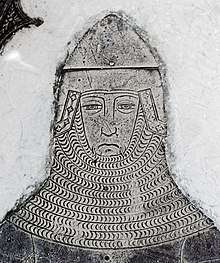
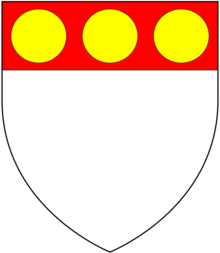
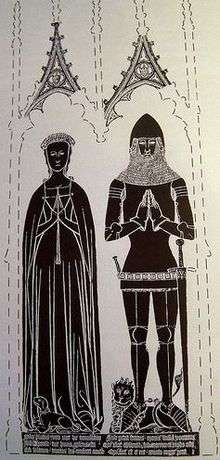
Family background
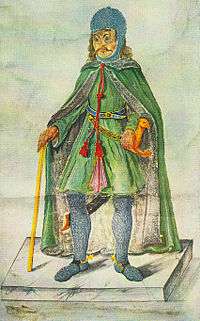
In 1626 the York Herald, William Le Neve, claimed descent for the family of Russell of Kingston Russell from a certain Norman knight, Hugo de Rosel,[2] but this has since been shown to be fanciful,[3] and in fact the family's earliest verifiable ancestor was living about 1200. The family was established at Kingston Russell in the parish of Long Bredy, near Swyre, in Dorset, at the start of the 13th century. About 1210 Sir John Russell (died c. 1224) held Kingston from King John (1199–1216) as half a hide by the serjeanty of being a marshal of the King's buttery on Christmas Day and at Whitsuntide, a service which had originated in the time of William the Conqueror.[4] The tenure was later said to be that of telling out the King's chessmen and putting them away when the King had finished his game.[5] Members of the family also held nearby Allington in Dorset from an early date, by serjeanty of presenting to the King a cup of wine at Christmas,[6] yet it appears in fact to have been part of the Domesday fief of Turstin FitzRolf, which later became the barony of Newmarch. John Russell was Governor of Corfe Castle in Dorset in 1220/1 and sometime Constable of Sherborne Castle, Dorset. He married Rose Bardolph, a daughter of Thomas Bardolph and Adela (or Sybil) Corbet.
Newmarch Inheritance
On the death in 1216 of his near neighbour in Dorset, James of Newmarch,[7] of North Cadbury in Dorset, last of that family, John Russell had purchased the wardship of his two daughters and co-heiresses, Isabel and Hawise, which transaction received the approval of King Henry III in 1224. Isabel, the elder, he married to his son Ralph Russell in 1219,[8] whilst he sold the marriage of Hawise to John de Bottrell.[9] On the death of Bottrell, Hawise married secondly Nicholas de Moels, to whom her moiety of the property descended. Thus were the lands of the extensive Newmarch barony, originally the Domesday Book fiefdom of Turstin FitzRolf, standard bearer to William the Conqueror at the Battle of Hastings, then the fief of Wynebald de Ballon, a soldier friend of King William II, split in two between the husbands of the two co-heirs. To Moels went North Cadbury and Upton “Moels” (Berks., now Oxon.), whilst to Ralph Russell went Dyrham and a moiety of Aust, (Glos.), Horsington (Som.), Upton “Russell” (Berks., now Oxon.), Hardwick & Kimble (Bucks.) & other estates in Wiltshire.[10] The Testa de Nevill entry for Dyrham was : “Jame de Novo Mercato tenet in Dorham cum pertinenciis duos milites et dimidium” (James of Newmarch held in Dyrham with appurtenances 2 ½ knights' fees).[11]
Gorges Inheritance
_Gorges.svg.png)
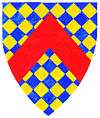
(See main article: Gorges family)
Ralph Russell's and Isabel's son Sir William Russell died as a young man in 1310/11, but not without having inherited in 1298 the lands of his two elder brothers, James (who had a son Ralph, d. 1295, s.p.) and Robert (died s.p. 1298). The Russell lands at Dyrham were in 1311 one of the largest arable demesnes in Gloucestershire, that is lands farmed in-hand, not let out to tenants, comprising 420 acres arable and 60 acres of meadow.[12] William produced a male heir, Theobald (1303–1349), by his wife Jane Peverell (or poss. Katherine de Aula from which family the Russells inherited Yaverland, Isle of Wight).[13] Thus, the infant Theobald, having lost father and grandfather, was granted by King Edward II in wardship to Ralph de Gorges, 1st Baron Gorges of Wraxall & Bradpole (Som.), Knighton (IoW), Tothill (Lincolnshire). In 1316, Theobald Russell, as a minor, was recorded as holding 8 manors; 2 in Glos., 1 in Wilts., 1 in Som. & 4 elsewhere.[14] Gorges had a son, Ralph, 2nd Baron Gorges, and 3 daughters, Elizabeth, Eleanor, and Joan. He appears to have married his second daughter Eleanor to the young Theobald Russell. Before the death of the 2nd Baron without issue shortly after his father, clearly keen to see his family name and armorials continue, he formed the plan of bequeathing the Gorges estates to the younger son of his sister Eleanor Russell, on condition, apparently, that he should adopt the name and arms of Gorges. This is precisely what occurred when Theobald Russell II, 3rd son of Theobald and Eleanor, his 2nd elder brother William having died, adopted the name Gorges, and founded a revived Gorges line, which flourished, based at Wraxall, Somerset. (see Gorges family and Ferdinando Gorges). When, however, Theobald “Gorges” tried to adopt the Gorges arms, taken from the Morville heiress who had brought them Wraxall, he was challenged by the Warburton (or Warbleton) knight of Cheshire who happened to be serving with him at the Siege of Calais in 1346, who noticed they both bore the same arms on their shields, "Lozengy or and azure". The case was brought before the Earl Marshal, who adjudged on 19 July 1347 in favour of Warburton and forced Theobald Russell "Gorges" to add a "chevron gules" to the Morville arms as a difference. Thus the new Gorges arms became "Lozengy or and azure, a chevron gules",[15] and one of the more celebrated and historic cases heard in the Earl Marshal's court was recorded.[16] The ancient Gorges canting arms of "Argent, a gurges azure", gurges signifying, in Latin, a whirlpool,[17] had been retained some generations before by the senior Gorges line seated at Tamerton Foliot, Devon, the cadet line having married the de Morville heiress. The eldest son of Theobald I, described as of Carisbrooke Castle, Isle of Wight, and Eleanor was Ralph Russell (died 13 February 1375),[18] described as “of the Isle of Wight”, the father of Sir Maurice Russell, the subject of the present article.
First marriage to Isabel Childrey



Maurice Russell, aged just 13, was married firstly in June 1369,[20] to Isabel Childrey, daughter of Sir Edmund Childrey (died 1372)(or Chelrey) of Frethornes Manor in the parish of Childrey, Berkshire. Frethornes was a manor anciently held from the Newmarch family, and its tenant prior to Edmund was the “de Frethorne” family, which held other Newmarch lands in Gloucestershire and Somerset.[21] Certainly Frethornes was part of the Newmarch moiety which had gone to the husband of Hawise, since the Bottreaux family, eventual heirs of Nicholas de Moels, were the overlords to Edmund.[22] Sir Edmund was from a relatively new gentry family, though long resident within the parish of Childrey, which rose rapidly in his own person, from his profession as a lawyer. His armorials in 1368, even at the height of his career, were stated in contemporary documents to be “unknown”, pointing to his family's lowly origins.[23] These armorials can be seen on the funerary brass in Dyrham church, above Isabel's figure (see illustration). He began his public career in 1343.[24] In 1348, he was a Commissioner of the Peace for Berkshire. In 1362, he was appointed a King's Serjeant-at-Law, rising to Justice of King's Bench in 1371, whereupon he was knighted. In 1355, he had begun to acquire property in Berkshire, at Watlingtons manor in West Hagbourne, Frethornes manor in Childrey Parish, South Fawley, Letcomb Bassett (Berks.) and Balsdon. On the marriage of Maurice Russell and Isabel, his father, Ralph Russell, settled upon them the manor of Dyrham.[25] His lands in the Isle of Wight, comprising three manors,[26] apparently were settled on the two elder brothers of Maurice who died without male issue,[27] but do not appear to have descended to Maurice. Edmund Childrey's connection with Gloucestershire, and thus with Maurice Russell's father, may have developed as a result of his having been granted, in 1362, the wardship of the lands of William FitzWarin at Whityngton, Glos.[28] In 1388, Sir Maurice Russell sold his ex-Newmarch Berkshire manor of Upton “Russell” to John Latton, who sold it in 1401[29] to Thomas Childrey (c. 1350-1407), MP for Berkshire in 1390 and 1406, brother-in-law to Maurice Russell[30] and steward of the estates of Bishop William of Wykeham of Winchester .
Becomes Ward on Father's Death
Maurice's father, Ralph Russell, died on 13 February 1375, while Maurice was still a minor, aged 19, two years from his majority. He was granted in wardship to Sir Robert Assheton (died 1384), his father's cousin, soon to be appointed Treasurer of the Exchequer. Having reached his majority, in December 1377, Maurice took possession of his inheritance, following the early deaths of his two elder brothers, Theobald and John(both fl. 1341),[31] excepting the customary 1/3 dower share retained by his mother Alice, whose family name is unknown, apparently resident at Kingston Russell, who died on 16 March 1388. In 1382, Maurice leased the reversion of Kingston Russell, from his mother's death, to Walter Clopton for 20 marks p.a. Maurice also had a sister, Alice, who married into the Haket family, producing a son John Haket (died 1498).
Inherits Assheton Lands
Sir Robert Assheton (senior) of Pitney, Somerset, had married Elizabeth de Gorges, eldest daughter of the first Baron Gorges. On the death of their son, Sir Robert Assheton (junior),[32] without issue, in 1384,[33] Maurice Russell inherited the former Gorges manors of Bradpole, and the hundred courts of Redhone and Beaminster Forum, in Dorset. Assheton's manor of Litton and Combe in Dorset were split, after some argument, between Russell and Sir Ralph Cheyne (died 1400), of Brooke in Westbury, Wilts., whose father, Sir William Cheyne, of Poyntington, Somerset, had married, as his second wife, Joan Gorges, the youngest daughter of the 1st Baron Gorges.[34]
Career
Maurice Russell's career began in December 1385 in connection with the administration of Gloucestershire, when he was appointed, aged 29, tax collector for Glos., and again in March 1388. In the same year of 1385 he sold the former Newmarch manor of Hardwick, Bucks. to William of Wykeham, Bishop of Winchester, for the purpose of the founding of New College, Oxford, and also granted the Bishop an annual rent of £10 from the manor of Aust, Glos., during his wife's lifetime. Later, in 1400, his brother-in-law Thomas Childrey would become steward to the estates of Wykeham.[35] He also sold the ancient Russell manor of Allington to John Roger I (died 1441), of Bridport and Bryanston, Dorset.[36] Russell remained a very wealthy man as the assessments made in 1412 for the purposes of taxation make clear. His estates in Hampshire, Somerset, and Gloucesterhire were then said to be severally worth £40 p.a., whilst those in Dorset apparently gave him an annual income of £122 5s, making a total, no doubt under-declared, of over £242.[37] In 1394, he was removed from the post of Coroner of Glos. for the reason that “He dwells not in the county”, although most of his official positions related to that county. He made a loan of £40 to King Richard II in August 1397.[38] He was clearly a supporter of King Richard, as he had married off his younger daughter to Richard le Scrope, 1st Earl of Wiltshire, one of the King's staunchest supporters, who was beheaded at Bristol, only 7 miles from Dyrham, by Henry Bolingbroke, in 1399. Russell, however, continued to serve in official positions in Gloucestershire after the usurpation of the throne, in 1399, by Henry IV. Indeed, he served as Knight of the Shire in 1402 and 1404. In 1403, he was among the prominent figures of Gloucestershire commissioned by the new King to select the best fighting men of the region to join the royal army in fighting the Welsh rebels under Owen Glendower, and, in the same year, he was appointed feoffee, by Sir John Luttrell, of the Somerset manor of East Quantoxhead. In 1408, he was involved in a dispute, of unknown cause, with the influential Sir Walter Hungerford, as a result of which both men were required to enter into recognizances for 1,000 marks each as surety that they would abide by the award of the Chancellor Thomas Arundel, Archbishop of Canterbury.
Tax Collector, Gloucestershire
- December 1385
- March 1388
High Sheriff of Gloucestershire
- 7 November 1390 – 21 October 1391
- 9 November 1395 – 1 December 1396
- 10 July 1400 – 8 November 1401
- 5 November 1406 – 23 November 1407 (Duties included holding in Gloucester the Gloucestershire elections to Parliament of 1407)
Coroner of Gloucestershire
- 1 February 1392 – 6 February 1394
- before 14 February 1397
Justice of the Peace, Gloucestershire
- 18 June 1394 – February 1406
- 4 July 1406 – February 1407
Commissioner of Enquiry
- May 1389, Concealments; Bristol, Devon, Glos., Som.
- May 1393, Disseisin, Glos.
- November 1398, Intimidation of a Jury
- June 1399, Eviction
- May, Nov. 1400, Trespass
- July 1401, Disseisin
- July 1403, Wastes
- February 1406, Disseisin
- March 1406, Obstruction of a road
- July 1392, Arrest
- Mar 1394, Oyer and Terminer, Bristol
- Mar 1401, Oyer & Terminer, Glos., Worcs.
- May 1395 & Jan 1396, to take Assizes of Novel Disseisin, Glos., Som.
- October 1398, Survey estates of Lords Appellant of 1387–8, Berks., Glos., Oxon.
- December 1399 & Sept., Nov. 1403, Array, Glos.
- December 1401, Collection of Aid
- May 1402, to make proclamation of Henry IV's Intention to Govern Well
- September 1405, to raise royal loans
Second marriage to Joan Dauntsey
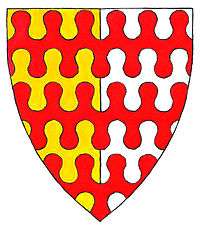

Before 1412, aged 56, Russell married 17-year-old Joan Dauntsey (c. 1395-1457), daughter of Sir John Dauntsey of Dauntsey, Wilts., by Elizabeth daughter and co-heiress of John Beverley of London, sister and eventual heiress of Sir Walter Dauntsey. Isabel Childrey had produced only 2 daughters for Russell, but now Joan produced a son and heir, Thomas (1412–1431). Thomas was aged only 4 at most when his father died in 1416, and was granted by King Henry V (1413–1422) in wardship to Thomas of Lancaster, 1st Duke of Clarence (1387–1421), the King's eldest brother. Thomas married young, no doubt at the direction of Clarence, and had a daughter Margery Russell, but father and daughter both died, in mysterious circumstances, in 1431, Thomas aged about 18, certainly still a minor. The elderly Sir John Stradling (died 1435)[39] of Glamorgan, Wales, obtained the marriage of Joan the young widow, yet omitted to obtain royal licence to marry a widow of a King's Tenant-in-chief, which Russell was regarding Dyrham and other manors, and was fined heavily in 1418 for his error.[40] The marriage occurred possibly as a result of Stradling's connection to Sir Gilbert Denys, Russell's son-in-law originally from Glamorgan. On Denys's death in 1422, the wardship of his son and heir Maurice Denys, Russell's grandson, was granted to Sir Edward Stradling (died 1453) of St Donat's Castle, Glamorgan, nephew of Sir John Stradling. Joan married thirdly, after 1435, John Dewall, next to whom she was buried in Dauntsey church in 1457.[41]
Succession
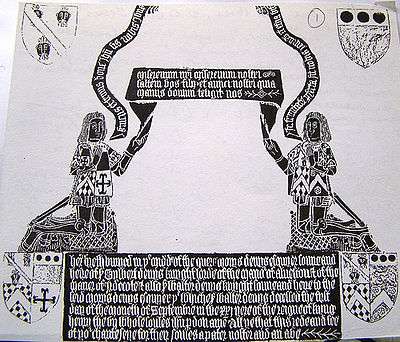
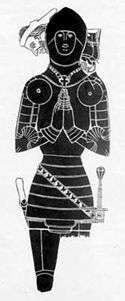
By 1st wife Isabel Childrey, on marriage to whom, in 1369, Dyrham and other estates were entailed to the progeny of the marriage:[42]
- (1) Margaret Russell (born c. 1383, died 1460) married twice:
- (1) c. 1404 as his 3rd wife, Sir Gilbert Denys (died 1422) of Siston, Gloucestershire. They had 3 sons, at least 1 daughter, including Maurice Denys (1409–1466).
- (2) John Kemys (died 1477). They had at least 1 son, Roger Kemys.
- (2) Isabel Russell (born c. 1386, died 1437) married 4 times:
- (1) William le Scrope, 1st Earl of Wiltshire, beheaded 1399 at Bristol by Henry Bolingbroke, Duke of Lancaster. He was a staunch adherent to Richard II, and a zealous treasurer of the Exchequer.[43] They had no issue.
- (2) Sir Thomas de la River (died 1406) of Tormarton & Acton Turville, Gloucestershire. They had one son, Maurice de la River, who inherited the Gorges manor of Bradpole, Dorset, which he sold in 1457 to the Earl of Ormonde.[44]
- (3) Sir John Drayton (died 1417) of Nuneham Courtenay.[45] They had two daughters, Joan Drayton, who married Drew Barantyne, her marriage having been purchased by Thomas Chaucer, 5 times Speaker of the House of Commons & son of the great poet Geoffrey Chaucer after Isabel and her fourth husband had sold the reversion of Drayton's manor of Nuneham Courtenay to him; and Elizabeth Drayton, who married 1stly Christopher Preston of Slapton, Northamptonshire, and 2ndly by 1437 John Wenlock, 1st Baron Wenlock, future Speaker of the House of Commons.
- (4) Stephen Hatfield (died 1461), Esquire.
Isabel and Drayton sold their share in the Russell lands to Margaret and her husband Sir Gilbert Denys, whose family retained Kingston Russell until 1543,[46] Dyrham until 1571[47] and Aust until after 1600.[48]
By 2nd wife Joan Dauntsey (c. 1395-1457):
- Thomas Russell (born c. 1412, died 1431), ward of Thomas of Lancaster, 1st Duke of Clarence, married, wife's name unknown, at unknown date, had 1 daughter, Margery (died 1431/2). Before his death in 1416 Sir Maurice Russell had placed the bulk of his lands into the hands of feoffees to act as trustees for his son Thomas during his minority. These feoffees included Sir William Hankeford, Chief Justice; Robert Hill, Justice of the Common Pleas; Sir William Cheyne (died 1420) of Brooke, Wilts, son of Sir Ralph (died 1400)[49] a cousin of Ralph Russell, Maurice's father;[50] Robert Poyntz of Iron Acton & Robert Stanshawe, Glos. Gentry. On Thomas's death in 1431, much of the Russell lands descended to his half-sisters Margaret and Isabel and their families, mainly passing into the Denys family, which long continued to quarter the Russell arms, for example on the 1506 Denys brass at Olveston Church, Glos. and on the facade of Siston Court, Glos., c. 1550. Some of Thomas's lands, especially those in the Isle of Wight, were inherited by John Haket (died 1498), his first cousin, son of Alice Russell, his aunt. The Haket family seem to have been connected with Wolverton Manor within Brading parish, Isle of Wight.[51] On the death of John Haket, his heir was his daughter Joan's husband, John Gilbert.
Dyrham Brass
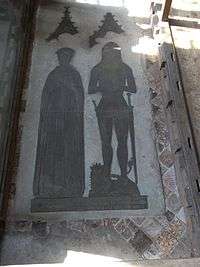
The monumental brass, created post-1416, of Sir Maurice Russell and his 1st wife Isabel Childrey is in the south chapel of St Peter's Church, Dyrham. It is over life-size, measuring 7 ft. 6in. by 3 ft. 11in., set into a surviving section of floor covered with mediaeval tiles.
Verse
It contains the following leonine verse below the feet of the subjects:
Miles privatus, vita jacet hic tumulatus
Sub petra stratus, Morys Russell vocitatus
Isobel spousa, fuit huius militis ista
Que jacet absconsa, sub marmorea modo cista
Celi solamen, Trinitas his conferat amen
Qui fuit et erit, concito morte perit
The coupling of stratus and vocitatus also feature on the tombstone of English design of Robert Hallam (died 1416), Bishop of Salisbury, at Constance Cathedral, Germany. Similar verse is shown on the contemporary brass of Sir Peter Courtenay (died 1405) at Exeter Cathedral, whose armoured figure is very similar to Russell's, which commences: Devoniae natus comes Petrusque vocatus. At least two renderings into English have been made of these verses, firstly by C. T. Davis, Monumental Brasses of Gloucestershire, 1899:[53]
Entomb-ed here bereft of life,
Behold a noble knight,
Beneath this stone he lieth prone,
Once Maurice Russell knight.And Isabel his loving spouse,
In marble rare enclosed,
Hidden from sight of earthly wight,
Hath here her limbs reposed.The joy of Heaven bestow on these,
Blest Trinity of grace,
Past present future death shall seize,
Who are of mortal race.
A second rendering was made by Raymond Gorges, History of the Family of Gorges, 1944:[54]
Bereft of life a knight lies here,
Stark stark beneath this stone lies he,
Sir Maurice Russell chevalier.
And by his side rests Isabel,
His wife in marble cold and drear.
Their span is o'er Blest Trinity
Celestial joys on them bestow,
Death called them as he calleth all
And when Death summons each must go.
A literal translation is as follows:
A knight deprived of life lies here buried,
Under a stone prostrate, Maurice Russell called.
That Isobel was wife of this knight,
Who lies concealed in a marble casket.
May the Trinity confer on these the comfort of Heaven Amen,
Who was is and will be perishes with death having been spurred on.
Description
- Sir Maurice wears armour similar to that shown in the brasses of Thomas de Berkeley, 5th Baron Berkeley (died 1417) at Wotton-under-Edge and of Sir Peter Courtenay (d.1405), KG, in Exeter Cathedral. The following description of the Dyrham brass is contained in Davis, C.T., op.cit.: He wears a bascinet helmet, camail and a habergeon of chain-mail, with back and breast plates and a jupon with a straight edge with plate armour over the arms and legs. The hands are protected by gauntlets which are plain at the wrists, where the lining is visible, and they are armed with only one row of gadlings. He wears no collar (i.e. Lancastrian et. alia). Gussets of mail are shown at the armpits, elbow joints, knees and feet. The jupon is confined to the hips by a horizontal baldric of square plates of metal richly chased and linked together, to which are attached the sword and misericorde. The misericorde, also called "dagger of mercy" or basilard, was used to give the coup de grace. It was a short dagger without a crossguard, worn on the right side, attached to the baldrick by a short cord or chain. The upper part of the sheath of the sword is ornamented with a rich tracery. The rowels of the spurs are clearly shown, his feet resting on a lion.
- Lady Russell wears the nebule head-dress, consisting of a caul of netting arranged in 3 rows on top of her head. Under the caul is a close-fitting embroidered cap, keeping the hair off the forehead. The head-dress conceals the ears and falls in a wavy line upon the shoulders, where the netting appears again. She is clothed in a mantle fastened by a cord. Above the hands are shown 5 buttons of the gown, cut higher than that of Lady Berkeley at Wotton. At her feet lies a little lap-dog with a collar of bells. The brasses are of fine quality and remain in excellent condition, the lack of wear due to years of protection from parishioners feet.
Sources
- Roskell, J.S. (ed.) et alia, The History of Parliament: The House of Commons 1386–1421, 4 vols., Stroud, 1992. Vol. 4, pp. 251–253, Russell, Sir Maurice, biography by L.S.Woodger.
- Scott-Thomson, Gladys. Two Centuries of Family History, London, 1930. Appendix D, pp. 324–328, Pedigree of Russell of Kingston Russell.
- Gorges, Raymond & Brown, Frederick, Rev., FSA. The Story of a Family through Eleven Centuries, Illustrated by Portraits and Pedigrees: Being a History of the Family of Gorges. Boston, USA, (Merrymount Press privately published), 1944.
- Wiffen, Jeremiah Holmes Historical Memoirs of the House of Russell, (2 Vols.), vol. 1, London, 1833, Russell of Dyrham, pp.142-155 (contains much inaccuracy)
- Round, J. Horace. Studies in Peerage and Family History, Vol. 2, London, 1901, pp.250-279, The Origin of the Russells (a severe critique of Wiffen's work)
- Davis Cecil T., The Monumental Brasses of Gloucestershire, London, 1899, reprinted Bath, 1969, pp. 25–28.
- Jefferies, P.J. Social Mobility in the Fourteenth Century: The Example of the Chelreys of Berkshire. Oxoniensia, Vol. 41, 1976, pp. 324–336.
- Victoria County History, Berkshire, 1923, Vol.3: Parishes of Blewbury with Upton and Aston Upthorpe: Upton, pp. 280–291.
- Victoria County History, Somerset (On-line texts in progress, Univ. of London, April 2007), North Cadbury.
- Victoria County History, Somerset, 1999, vol.7: Bruton, Horethorne & Norton Ferris Hundreds: Horsington, pp. 119–131
- Sanders, English Baronies, p. 68. (Newmarch)
- Saul, Nigel. Knights and Esquires: The Gloucestershire Gentry in the Fourteenth Century, Oxford, 1981
References
- Davis C.T. The Monumental Brasses of Gloucestershire, London, 1899, reprinted Bath, 1969, pp.25-28. The Russell arms are shown with ensquared quatrefoil diapering in the field
- Scott-Thomson, 1930, p.30. Le Neve produced a superbly illustrated pedigree roll for the 3rd Earl of Bedford, which family of Russell was long believed, erroneously as Scott-Thomson has shown, to be descended from the Russells of Kingston Russell
- Scott Thomson, 1930
- Testa de Nevill (Rec. Comm.), 165; Red Book of Exchequer (Rolls Series), 546
- Calendar of Chancery, Inquisitiones post Mortem, vol. vii, p. 220
- Roskell, 1992, p. 251
- James was son of Henry of Newmarch, who in 1166 certified his knights fees to be 16 ½ (Cartae Baronum)
- Jefferies, 1976, p. 331
- Close Rolls, 2 Henry III, confirming grant to John de Bottrell.
- Collinson, “Somerset”, vol. 2, p. 372; Rudder, “Glos.”, p. 428; Victoria County History, “Berkshire”, vol. 3, p.283; VCH Bucks., vol. 2, p.303, vol. 3, p.363
- (Bristol & Gloucester Archaeological Society (BGAS) vol.12, pp. 254-6)
- Saul, 1981, p. 215 (Glos. Inq. p.m.'s, vol. 5, pp.120-1)
- Victoria County History, Hampshire, 1912, vol.5, Parishes: Yaverland, pp. 206-208.
- Saul, 1981, p. 227.
- Burke's Armorials, 1884, p. 413, which however gives the incorrect date, obtained corrected from Raymond Gorges's History of the Gorges Family
- For the most celebrated such case see Scrope v Grosvenor
- Cassell's Latin Dictionary, 260th Thousand, Marchant & Charles: Gurges-itis (m), (from root GAR to swallow) a whirlpool, eddy, abyss
- date of death per Roskell, p.252
- Gorges, Raymond, op.cit., p.31 gives the Childrey arms reversed and imprecisely; Clarke, William Nelson, Parochial Topography of the Hundred of Wanting: With Other Miscellaneous ..., p.33 , gives the arms of "Chilrey of Chilrey" as Argent, a whirlpool gules; a whorl and concentric circles both represent the heraldic charge of a whirlpool, as for example in the better known arms of Gorges
- Roskell, 1992, p.251
- Jefferies, 1976, p.330
- Jefferies, 1976, p.331; Victoria County History, Berkshire, 1924, vol.4: Parishes, Childrey, pp.272-279
- Jefferies, 1976, p.330
- Jefferies, 1976, p.327
- Cal. Patent Rolls 1367-70, p.281; Cal Fine Rolls, vol. 14, p.175,176. Quoted in Jefferies p.331, footnote 62; Saul,1981, p.31, footnote 109
- Roskell, 1992, vol. 4, p.251
- Roskell, p.251.
- Jefferies, 1976,p.328
- Cal. Patent Roll, 1399-1401, 423. Quoted in Jefferies, 1976, p.333, footnote 97
- VCH Berks, vol.3, Upton; Roskell, History of Parliament, House of Commons 1386-1421, vol. 1, p.566, Childrey, Thomas
- Feet of Fines, divers co's., 15 EdIII, 290
- Not to be confused with the unrelated Sir Robert I Ashton (d.1385) of Ashton-under-Lyne
- Roskell, op. cit., p.252: "In the meantime, when Russell's former guardian, Assheton, had died childless in 1384, he had inherited his manor of Bradpole and the hundreds of R & BF in Dorset"
- Roskell, 1992, op. cit. vol. 2, Cheyne, pp.554-555
- Roskell, 1992, vol 1, p.566
- Roger was MP for Bridport in 1395, 1410 and 1413, and for Dorset in 1421, per Roskell, 1992, vol.4, pp.226-228
- Roskell, 1992, p.252
- Roskell, 1992, vol.4, p.252
- Roskell, 1992, vol 4, p.253
- Patent Rolls, “8 July 1418, at Waltham. Pardon, for 40 marks paid in the hanaper, to John Stradlyng, chivaler, and Joan late the wife of Maurice Russell, chivaler, tenant-in-chief, of their trespass in intermarrying without licence”
- Roskell, 1992, vol.4, p.253
- Cal. Patent Rolls 1367-70, p.281
- Roskell, 1992, p. 252
- Scott Thomson, p.103.
- Victoria County History, Oxford, 1957, vol.5, Bullingdon Hundred: Parishes: Nuneham Courtenay, pp.234-249
- Kingston Russell was sold by Sir Maurice Denys(1516-63) on 2 March 1543/4 to the Crown (Duke of Bedford's MSS, copy indenture), quoted in Scott-Thomson, Appendix D, p. 326
- Dyrham was sold by Sir Walter Denys, elder brother of Maurice, in 1571 (Bindoff, S.T. The History of Parliament: House of Commons 1509-1558, vol. 2, pp.36-37)
- Aust remained with the Denys family until after 1600, Richard Denys (died 1593) having sold it to his younger brother Thomas Denys, son-in-law of Thomas Bell the Younger of Gloucester. The Visitation of the County of Gloucester taken in the year 1623 by Henry Chitty. Sir J. Maclean (ed.) London, 1885. Dennis pedigree pp.49-53)
- Roskell, House of Commons 1386-1421, 1992, vol.1, p.558-9, Sir William Cheyne (c. 1374-1420), MP for Dorset 1402
- Son of Sir Ralph Cheyne (c. 1337-1400) of Brooke in Westbury, Wilts., MP for Wiltshire 1378, 1386, 1388(Sept)(Per Roskell, op. cit. p.554-555. Ralph was the son of Sir William Cheyne of Poyntington, Som., by Joan, sister & co-heiress of Ralph Gorges, 2nd Baron Gorges
- Victoria County History, Hampshire, 1912, vol.5, pp.156-170, Brading Parish
- Transactions of Bristol & Gloucestershire Archaeological Society, vol. 23,p.77
- Davis, C.T., Monumental Brasses of Gloucestershire, London 1899, pp. 25-7
- Gorges, R. op.cit., p.32